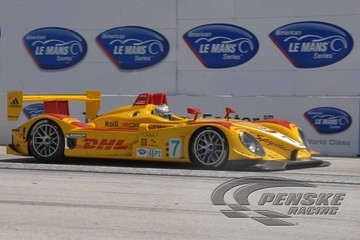Penske Porsches Ready for Long Beach Street Scrap
April 16, 2008
LONG BEACH, Calif. (April 16, 2008) – Southern California has long been the unofficial U.S. headquarters for Porsche sports cars, since the company started importing cars to the United States in 1948. Names like Vasek Polak, James Dean, Johnny von Neumann, Dan Gurney, Richie Ginther, and Merlin Olsen (yes, the football player who was also the FTD spokesperson had a Porsche dealership for years) are all names linked to Porsche and Southern California as the brand gained recognition in the ‘50s and ‘60s.
The Toyota Grand Prix of Long Beach, since the inaugural Formula 5000 pilot race in 1975 won by Brian Redman, has also been a race that has shaped the automotive legacy of Southern California. When the street circuit was turned over to Formula one in 1976, the likes of Clay Regazzoni, Mario Andretti, Carlos Reutemann, Gilles Villeneuve, Nelson Piquet, Alan Jones, Niki Lauda, and John Watson scored victories here. CART/Champ Car winners over the last decade have included Mario and Michael Andretti, Al Unser, Jr., Danny Sullivan, Alex Zanardi, Jimmy Vasser and, for the last three years, Sebastien Bourdais.
Now, for the second year in a row, the sports cars of the American Le Mans Series are back to give the fans the classic battles they want from the brands they drive on the street: Porsche versus Acura in LMP2; Porsche versus Audi overall; and Porsche versus Ferrari in GT2 – all in this Saturday’s Toyota Grand Prix of Long Beach’s Tequila Patron American Le Mans Series Race to be telecast Sunday at 3:30 PM (Eastern time – tape delayed) on ABC-TV.
The race can be heard live starting at 7:10 PM Eastern time on Saturday,
April 19, on American Le Mans Radio at www.americanlemans.com, which will also have live timing and scoring.
“On top of all that heritage, Southern California is the home of Porsche Motorsport North America (PMNA), and it is with great pride that we are able to bring our staff to the event to watch Porsche race cars we helped develop and prepare race for the checkered flag,” said Paul Ritchie, president of the Santa Ana-based organization which is a subsidiary of the Porsche factory in Germany.
“After a thrilling one-two-three finish for the Porsche RS Spyder LMP2 prototypes at Long Beach a year ago, and two straight class wins so far in 2008, we have been buoyed by the success of the V-8 racers, but the Acuras had the pole a year ago, and they have been even stronger so far this season, so that should be quite a contest,” said Ritchie.
After an excellent start to the season with two wins from two races, the Penske Racing Porsche RS Spyder returns to the place of their greatest success last season. On the famed city circuit in Long Beach, where the third round of the American Le Mans Series is contested on Saturday, the sports prototypes from Weissach celebrated a historic triumph last year with their phenomenal sweep of the podium.
“This race is the highlight of the year, it’s a fascinating mix of sport and show,” says Timo Bernhard (Germany), who won here in his first attempt last year with his Penske Racing teammate Romain Dumas (France), not only winning overall, but defeating the more powerful LMP1 Audi R10s. “The demanding track and the whole atmosphere with its many attractions for the fans make it a one-of-a-kind experience.”
Traditionally, the Grand Prix weekend in Long Beach is packed full with thrilling racing. Running alongside the American Le Mans Series is the USA’s equally as popular IndyCars as the main attraction on the 1.968-mile city circuit, on which four 476 hp RS Spyder will compete again.
Penske Racing, winner of the LMP2 class team championship in 2006 and 2007, fields two of the successful sports prototypes: the No. 6 vehicle with Sascha Maassen (Germany) and Patrick Long (USA) as well as the No. 7 car with reigning champions Timo Bernhard and Romain Dumas.
Bernhard and Dumas currently hold a 14-point lead in LMP2 over the nearest Acura competitors.
Only 100 minutes from start to finish makes Long Beach the shortest race of the year, a sprint race where every second counts. An unplanned pit stop or one that doesn’t run smoothly has an exaggerated negative effect. The drivers also know that the smallest mistake in their full speed ride between the walls and fences can relegate them far back into the field and rob them of the rewards of their hard work.
“The reasons for our success last year was Penske Racing’s perfect pit stop strategies plus we managed to find an optimal set-up for the RS Spyder in the short practice time. These have to be our main focus this year too,” said Hartmut Kristen, head of Porsche Motorsport worldwide.
Maassen, a street circuit veteran, describes he greatest challenge for the drivers on this narrow circuit, where there is little chance to overtake.
“It is crucial to use every minute of the free practice and secure a good starting position in qualifying. Only when we can do this do we have a chance of winning our class against the strong competition,” said Maassen, who has won ALMS titles both in LMP2 and GT2 Porsches.
Facts and Figures
This is the American Le Mans Series
The American Le Mans Series (ALMS) was created in 1999. The regulations are based on the rules of the Le Mans 24 hour race. This season eleven rounds will be contested in the USA and Canada. The traditional highlights of the year are the Sebring 12 hour race and the 1,000 mile “Petit Le Mans” race at Road Atlanta. Most races run over 2.45 hours. The ALMS is the American counterpart to the European-based Le Mans Series (LMS).
The starting field consists of two different sports vehicle categories:
Sports prototypes and production-based sports cars. They are divided into four
classes:
LMP1 class: Sports prototypes with up to 750 hp and a minimum weight of 925 kilograms (in the European LMS: 750 hp/900 kilograms).
LMP2 class: Sports prototypes with around 475 hp (normally-aspirated
engines) and an 800 kilogram minimum weight (in the European
LMS: 475 hp/825 kg). The Porsche RS Spyder competes in this class.
GT1 class: Heavily modified production-based sports cars with up to 650 hp and a minimum weight of 1,125 – 1,325 kilograms (in the European LMS: 650 hp/1,125 – 1,325 kilograms).
GT2 class: Modified production-based sports cars with between 450 hp to 470 hp and a minimum weight of 1,125 – 1,325 kilograms (in the European LMS: 450 to
470 hp/1,125 – 1,325 kilograms). The Porsche 911 GT3 RSR competes in this class.
All race cars start together but are classified separately according to the class. This system ensures diverse and gripping racing with many overtaking opportunities. Points are only allocated for top-ten finishes in each class.
Championship titles are awarded in all classes for drivers, chassis and engine manufacturers, teams and tire suppliers.
With the RS Spyder in 2006 and 2007, Porsche won the championship title for drivers (Sascha Maassen/Lucas Luhr and Timo Bernhard/Romain Dumas
respectively) as well as for manufacturer chassis, manufacturer engine and team (Penske Racing).

